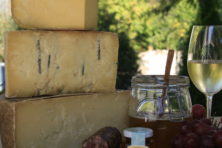The Cheese Insider
- Share
- Tweet
- Pin
- Share
Bandaged Cheddar
Bleu Mont Dairy, Blue Mounds, Wis.
Cheesemaker Willi Lehner makes what I consider to be one of the best cheddars anywhere. His Bandaged Cheddar is a true classic, made in the style of what is known as “farmhouse bandaged cheddar.”

Cheesemaker Willi Lehner, of Bleu Mont Dairy in Blue Mounds, Wisconsin.
To make Cheddar, the curds are gathered into large slabs at the side of the cheese vat, then the slabs are stacked by hand two or three high and repeatedly turned or flipped. Lehner controls the loss of whey and the development of acid by the height of the stack.
When the acidity is what he is looking for, the curds are milled and packed in cheesecloth-lined molds. The wheels are pressed to tighten the texture, then taken out of the molds and sent to an aging room for a stay that may last from nine months to two years.
Lehner’s cheddar has a firm texture that manages to be simultaneously crumbly yet creamy. The acidity is pronounced and the aromas are profound: grassy, fruity, nutty, often with caramel notes. When the cloth bandage is removed from the wheels, the aroma is very earthy, or as some people say: “barnyard” … is that really a word?
Wines that work: You need a red wine with some intensity. Zinfandel, Merlot, Cabernet Sauvignon work well. A good, aged port also works very well.
Pleasant Ridge Reserve
Uplands Cheese, Dodgeville, Wis.
Cheesemaker Andy Hatch makes a true American classic that can be found in some of the finest cheese shops worldwide. Pleasant Ridge Reserve is a raw milk, alpine-style cheese, inspired by two of Europe’s most famous cheeses: Gruyere, and Beaufort.

Cheesemaker Andy Hatch, of Uplands Cheese in Dodgeville, Wisconsin.
Rare among American cheeses, Pleasant Ridge Reserve is made with the unpasteurized milk of a single herd and only during pasture season, late spring till early fall. The “rotational” grazing practices at this farm ensures that the mix breed herd of cows eats lush grasses and wildflowers that clearly have a big influence in the flavor of the milk.
After the wheels of this cheese are ready to go into a climate controlled aging room, or cave, the work continues. The wheels are repeatedly rubbed by hand with a brine solution and turned or flipped every day for a period of time. The brine/solution keeps undesirable molds at bay while allowing flavor and aroma-imparting bacteria to do their work. This cheese develops a thin, hard, natural rind and a golden color in the interior.
Pleasant Ridge can be aged anywhere from four months when it is still moist and fairly mild, until two years when it becomes a firm, more intense cheese. This cheese clearly has a caramel, nutty, almost “meaty” taste, especially as it ages.
Wines that work: A dry Pinot Gris or Riesling, a French Chablis, or an unoaked Chardonnay. If you prefer a red wine, try a Pinot Noir or another medium-weight red. If pairing with an aged version of this cheese, try a more robust red.
Source: Cheese & Wine: A Guide to Selecting, Pairing and Enjoying by Janet Fletcher



